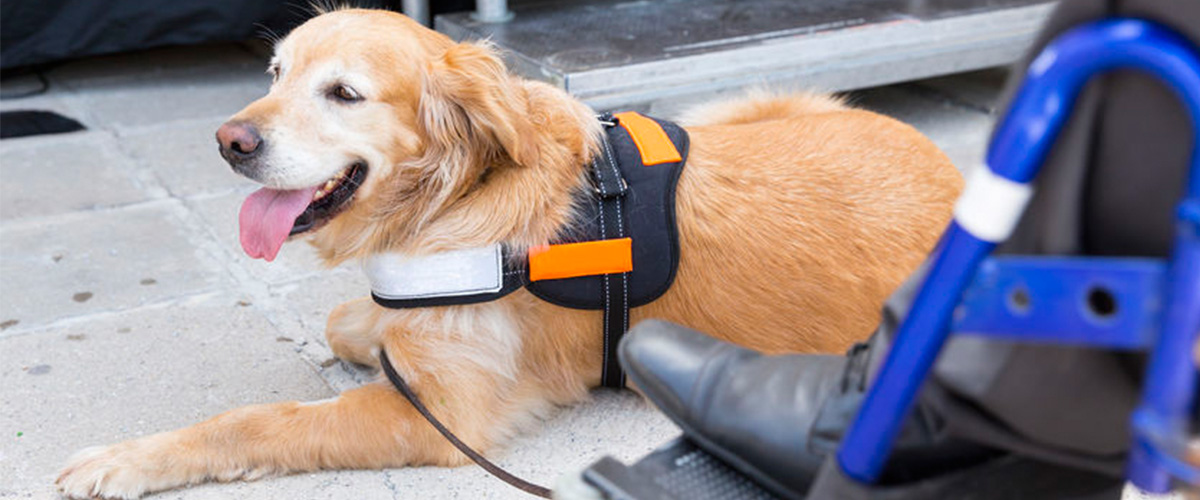
Do Service Dogs Help Treat PTSD
Today, there are more than 1.7 million veterans who receive mental health care through the Department of Veterans Affairs. Many of whom have received a PTSD, or post-traumatic stress disorder diagnosis. PTSD is a severe anxiety disorder triggered by traumatic events or a series of events. The severity of the mental disorder ranges from person to person. In recent years, mainstream discussion about mental health has made it less of a taboo topic. There is also more discussion about alternative treatments. One such treatment is using psychiatric service dogs as a form of mental health therapy. Currently, the Department of Veteran’s Affairs (VA) refuses to cover the costs of service dogs as a treatment for PTSD. They consider psychiatric therapy dogs an “unsubstantiated treatment regime.”
The VA does cover the costs of veterinary care and the equipment costs of service dogs for veterans with certain disabilities, like blindness or hearing loss. But service dogs can also be trained to alleviate some of the symptoms associated with PTSD. PTSD can manifest in many different ways. For example, a veteran may experience any combination of the following as part of their PTSD diagnosis:
- Severe anxiety
- Panic attacks
- Insomnia
- Fear of crowds
- Flashbacks
- Depression
- Mood swings
It should be noted that PTSD can arise from a number of traumatic incidents in a person’s life. Traumas can come from childhood abuse, physical or sexual assault, witnessing an accident or fatality, surviving a natural disaster, or military combat. Overcoming these events may take years. But with effective treatment, those suffering from the condition may be able to go about their daily routines.
Types of Post Traumatic Stress Disorder the VA recognizes
Over the years, the VA has relaxed its eligibility requirements for PTSD diagnosis. Between 2008 and 2017, the number of PTSD disability claims nearly tripled. In fact, according to the VA National Suicide Data Report 2005-2016, the suicide rate for veterans was 1.5 times greater than non-veteran adults. Further, veteran suicides averaged 6,000 per year between 2008 and 2016. Currently, the VA endorses two types of cognitive behaviors to treat PTSD:
- Prolonged exposure and cognitive processing
- Eye movement desensitization and reprocessing (EMDR)
Additionally, the VA prescribes antidepressants medications like Zoloft, Prozac, and Paxil. However, studies reveal that psychotherapeutic remedies reveal that prolonged treatment is not effective in 40% of veterans of PTSD.
How do service dogs help with mental issues?
Animals have a long history of inclusion in psychiatric treatment. It’s a practice known as Animal-Assisted Intervention (AAI). For centuries, humans have relied on dogs to act as guides, aides and helpers. Time has given dogs more official roles to play in the lives of those who need physical and emotional assistance. These animals help by providing a sense of safety and security, physical exercise and other tasks that lessen the impact of the disability. Service dogs can:
- Reduce anxiety
- Reduce depression
- Increase serotonin
- Lower blood pressure
Service dogs are trained to accomplish specific tasks no matter the disability of the owner. However, in the case of psychiatric service dogs, the tasks they complete are very specific to helping their partners through mental episodes or triggering situations. Service dogs can help their partners in the following ways.
Alert tasks
PTSD service dogs can help their partners remember when to take specific medications or routines. In addition, they can alert them to dangerous situations such as an approaching person or car or home intruders. In some cases, these dogs can even warn their partners of dangerous chemical levels in the body such as high blood pressure, cortisol or a panic attack or if warn a family member if their partner needs help.
Interruption tasks
Psychiatric service dogs can be trained to interrupt a flashbacks, nightmares, panic attacks, self-harm, harm to others, disassociation, freezing out of fear and repetitive behaviors. To do so, these dogs can lick the handlers face or hands, lay on the handler’s chest, nuzzle or instigate play by bringing a toy or stick.
Movement tasks
Service dogs can also help those who suffer from anxiety through crowded places. Often, those living with PTSD may fear things like being approached from behind or not knowing what to expect when entering a house or building. Service dogs can be trained to provide crowd control by circling the handler when in a crowded place. This act creates a barrier between the handler and the crowd around.
Guide tasks
These tasks are mostly associated with service dogs who lead the blind. However, there are several tasks that service dogs can perform for those with PTSD. These dogs can sense tense situations and will be able to lead their handler away from a situation that may trigger a panic attack or other danger. These dogs can guide their handler home or to the nearest exit.
Is there a difference between an Emotional Support Animal and a Service Dog
Yes. Emotional Support Animals (ESAs) can be any kind of animal. Generally, these animals don’t go through the rigorous training that service dogs do.
A service dog is trained to perform a function or do a job that his or owner can’t perform on their own. The assistance they perform is generally because of their handlers physical, intellectual or emotional disability. While these dogs can also provide emotional support, they are trained to provide assistance beyond soothing benefits.
An emotional support animal, on the other hand, is a companion animal, not a work animal. They also are not required to be dogs. Its purpose is to provide therapeutic or emotional support and comfort to a person with a medically diagnosed disability. ESAs don’t enjoy the same legal protections as service dogs. Why is the VA opposed to providing psychiatric service dogs?
There are several nonprofit organizations across that country that specialize in training service dogs for veterans. However, because there is no VA support, there are no clear standards for the type or level of training a dog should receive. These animals are also extremely expensive because they require 600 hours of training in addition to veterinarian bills and fostering.
In an interview with National Public Radio (NPR), the VA’s chief veterinarian said that there is no scientific evidence that service dogs help in treating mental health issues. For this reason, the VA only pays for PTSD therapy that is evidence-based.
Approximately one in five veterans suffers from PTSD and about 20 veterans per day commit suicide.
The VA’s failed service dog pilot study
In 2009, a former senator introduced the first Senate bill to call for the VA to complete a three-year pilot study into the benefits and feasibility of using service dogs to treat PTSD. At the time, there was little research on what could be done The bill received bipartisan support and was incorporated in the 2010 defense budget. The act failed almost immediately.
First, the VA partnered with vendors whose poorly trained animals introduced unexpected complications. In addition, the agency failed to supervise the vendors’ screening for health problems or aggressive behavior in their animals. This lack of oversight led to the following disastrous results:
- 25% of the dogs developing hip dysplasia
- Two dogs bit children
- One dog died of an undiagnosed disease
- One with a spinal tumor was euthanized
Further, contractors discouraged participants from reporting problems with their dogs to the VA. This tainted early findings in the study. For these reasons, the agency suspended its trial twice in 2012.
Can the PAWS Act help?
The Puppies Assisting Wounded Servicemembers Act is a piece of bipartisan legislation was first introduced in 2016. The PAWS Act was introduced again in June 2019 with the intent to establish a grant program to support providing service dogs to certain veterans with PTSD. These grants are set to $25,000 or less for each veteran who could be paired with a service dog.
Further, the bill calls for a report through the Government Accountability Office to better understand how the programs can help veterans with PTSD reacclimate to civilian life.
We are Veterans Helping Veterans
With the right training, psychiatric service dogs can be of assistance to veterans with PTSD. The Veteran Legal Assistance Program is here to support veterans and active-duty soldiers as they reacclimate to civilian life. In addition to offering valuable information, we are here to amplify the voices of veterans and their families. If you are in need of assistance, contact the Veterans Legal Assistance Program and let us know how we can help.
We’ve got your six.



